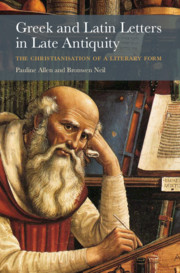Book contents
- Greek and Latin Letters in Late Antiquity
- Greek and Latin Letters in Late Antiquity
- Copyright page
- Contents
- Acknowledgements
- Abbreviations
- Chapter 1 Introduction to Late Antique Letters
- Chapter 2 The Christianisation of the Late Antique Letter-Form
- Chapter 3 Preservation and Transmission
- Chapter 4 Letter-Types and Their Uses
- Chapter 5 Difficulties in Spreading the Word
- Chapter 6 Networks and Communities of Readers
- Epilogue
- Book part
- Bibliography
- Index
Chapter 2 - The Christianisation of the Late Antique Letter-Form
Published online by Cambridge University Press: 05 September 2020
- Greek and Latin Letters in Late Antiquity
- Greek and Latin Letters in Late Antiquity
- Copyright page
- Contents
- Acknowledgements
- Abbreviations
- Chapter 1 Introduction to Late Antique Letters
- Chapter 2 The Christianisation of the Late Antique Letter-Form
- Chapter 3 Preservation and Transmission
- Chapter 4 Letter-Types and Their Uses
- Chapter 5 Difficulties in Spreading the Word
- Chapter 6 Networks and Communities of Readers
- Epilogue
- Book part
- Bibliography
- Index
Summary
In this chapter we consider the differences and similarities between Classical and Christian approaches to epistolarity in Late Antiquity, and the extent to which we can speak of the ‘Christianisation’ of the letter-form in that period. We provide a consideration of the materials and mechanics of letter-writing in Antiquity, including materials, length of letters, dictation, scribes, autograph, and signature. After an assessment of the ‘pagan-Christian divide’, we take cognisance of the tropes of the letter and how Christianity made its mark in this regard. Subsequently we discuss literary vs papyrological letters. Finally we look at the various modes of address used by pagans and Christians in their letters.
- Type
- Chapter
- Information
- Greek and Latin Letters in Late AntiquityThe Christianisation of a Literary Form, pp. 24 - 46Publisher: Cambridge University PressPrint publication year: 2020

